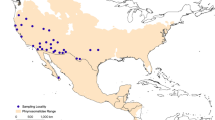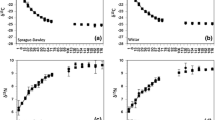Abstract
The application of allometric, or mass-dependent, relationships within radioecology has increased with the evolution of models to predict the exposure of organisms other than man. Allometry presents a method of addressing the lack of empirical data on radionuclide transfer and metabolism for the many radionuclide–species combinations which may need to be considered. However, sufficient data across a range of species with different masses are required to establish allometric relationships and this is not always available. Here, an alternative allometric approach to predict the biological half-life of radionuclides in homoeothermic vertebrates which does not require such data is derived. Biological half-life values are predicted for four radionuclides and compared to available data for a range of species. All predictions were within a factor of five of the observed values when the model was parameterised appropriate to the feeding strategy of each species. This is an encouraging level of agreement given that the allometric models are intended to provide broad approximations rather than exact values. However, reasons why some radionuclides deviate from what would be anticipated from Kleiber’s law need to be determined to allow a more complete exploitation of the potential of allometric extrapolation within radioecological models.
Similar content being viewed by others
Notes
Nagy (2001) presents relationships based upon mass in units of grams; we have converted these to kilograms.
References
Agutter PS, Tuszynski JA (2011) Analytic theories of allometric scaling. J Exp Biol 214:1055–1062
Avila R, Beresford NA, Agüero A, Broed R, Brown J, Iospje M, Robles B, Suañez A (2004) Study of the uncertainty in estimation of the exposure of non-human biota to ionizing. J Radiol Prot 24:A105–A122
Barnett CL, Beresford NA, Walker LA, Baxter M, Wells C, Copplestone D (2013) Element and radionuclide concentrations in representative species of the ICRP’s reference animals and plants and associated soils from a forest in north-west England. NERC-Environmental Information Data Centre. doi:10.5285/e40b53d4-6699-4557-bd55-10d196ece9ea
Battiston GA, Degetto S, Gerbasi R, Sbrignadello G, Parigi-Bini R, Xiccato G, Cinetto M (1991) Transfer of Chernobyl fallout radionuclides from feed to growing rabbits: cesium-137 balance. Sci Total Environ 105:1–12
Beresford NA, Broadley MR, Howard BJ, Barnett C, White PJ (2004) Estimating radionuclide transfer to wild species - data requirements and availability for terrestrial ecosystems. J Radiol Prot 24:A89–A103
Beresford NA, Barnett CL, Brown J, Cheng J–J, Copplestone D, Filistovic V, Hosseini A, Howard BJ, Jones SR, Kamboj S, Kryshev A, Nedveckaite T, Olyslaegers G, Saxén R, Sazykina T, Vives i Batlle J, Vives-Lynch S, Yankovich T, Yu C (2008) Inter-comparison of models to estimate radionuclide activity concentrations in non-human biota. Radiat Environ Biophys 47:491–514
Brown J, Børretzen P, Dowdall M, Sazykina T, Kryshev I (2004) The derivation of transfer parameters in the assessment of radiological impacts on Arctic marine biota. Arctic 57:279–289
Coughtrey PJ, Jackson D, Thorne M (1983) Radionuclide distribution and transport in terrestrial and aquatic ecosystems a critical review of data, vol 3. AA Balkema, Rotterdam
Gaare E, Staaland H (1994) Pathways of fallout radiocaesium via reindeer to man. In: Dahlgaard H (ed) Nordic radioecology—the transfer of radionuclides through Nordic ecosystems to man. Elsevier, Amsterdam, pp 303–334
Galeriu D, Beresford NA, Takeda H, Melintescu A, Crout NMJ (2003) Towards a model for the dynamic transfer of tritium and carbon in mammals. Radiat Prot Dosimetry 105:387–390
Higley KA (2010) Estimating transfer parameters in the absence of data. Radiat Environ Biophys 49:645–656
Higley KA, Bytwerk DP (2007) Generic approaches to transfer. J Environ Radioact 98:4–23
Higley KA, Domotor SL, Antonio EJ (2003) A kinetic-allometric approach to predicting tissue radionuclide concentrations for biota. J Environ Radioact 66:61–74
Hoppeler H, Weibel ER (2005) Editorial Scaling functions to body size: theories and facts. J Exp Biol 208:1573–1574
International Atomic Energy Agency (IAEA) (1994) Handbook of transfer parameter values for the prediction of radionuclide transfer in temperate environments. Technical report series 364. International Atomic Energy Agency, Vienna
International Atomic Energy Agency (IAEA) (2010) Handbook of parameter values for the prediction of radionuclide transfer in terrestrial and freshwater environments. Technical reports series no 472. International Atomic Energy Agency, Vienna
International Atomic Energy Agency (IAEA) (in press) Handbook of parameter values for the prediction of radionuclide transfer to wildlife. Technical report series. International Atomic Energy Agency, Vienna
International Commission on Radiological Protection (ICRP) (1979) Limits for intakes of radionuclides by workers. ICRP publication 30 (Part 1). Ann ICRP 2(3–4). http://www.icrp.org/publications.asp
International Commission on Radiological Protection (ICRP) (1981) Limits for intakes of radionuclides by workers. ICRP publication 30 (Part 3). Ann ICRP 6(2–3). http://www.icrp.org/publications.asp
International Commission on Radiological Protection (ICRP) (1988) Limits for intakes of radionuclides by workers: an addendum. ICRP publication 30 (Part 4). Ann ICRP 19(4). http://www.icrp.org/publications.asp
International Commission on Radiological Protection (ICRP) (2006) Human alimentary tract model for radiological protection. ICRP publication 100. Ann ICRP 36(1–2). http://www.icrp.org/publications.asp
Isaac NJB, Carbone C (2010) Why are metabolic scaling exponents so controversial? Quantifying variance and testing hypotheses. Ecol Lett 13:728–735
Johansen MP, Barnett CL, Beresford NA, Brown JE, Černe M, Howard BJ, Kamboj S, Keum D-K, Smodiš B, Twining JR, Vandenhove H, Vives i Batlle J, Wood MD, Yu C (2012) Assessing doses to terrestrial wildlife at a radioactive waste disposal site: inter-comparison of modelling approaches. Sci Total Environ 427–428:238–246
Kitchings T, DiGregorio D, Van Voris P (1976) A review of the ecological parameters of radionuclide turnover in vertebrate food chains. In: Cushing CE, Cutshall NH, Fraley LF, French NR, Murphy PG, Sharitz RR, Trabalka JR, Turner FR, Whicker FW, Wolfe DA (eds) Radioecology and energy resources. Dowden, Hutchinson & Ross, Inc., Stroudsburg, PA, pp 304–313
Kleiber M (1932) Body size and metabolism. Hilgardia 6:315–353
Kleiber M (1947) Body size and metabolic rate. Physiol Rev 27:511–541
MacDonald CR (1996) Ingestion rates and radionuclide transfer in birds and mammals on the Canadian shield. Report TR-722 COG-95-551. Atomic Energy of Canada Limited, Ontario
Nagy KA (2001) Food requirements of wild animals: predictive equations for free-living mammals, reptiles and birds. Nutr Abstr Rev 71:21R–31R
Nagy KA (2005) Field metabolic rate and body size. J Exp Biol 208:1627–1634
Peters RH (1983) The ecological implications of body size. Cambridge University Press, Cambridge
Savage VM, Deeds EJ, Fontana W (2008) Sizing up allometric scaling theory. PLoS Comput Biol 4(9):e1000171
Sazykina TG (2000) ECOMOD—an ecological approach to radioecological modelling. J Environ Radioact 50:207–220
Sheppard SC (2001) Toxicants in the environment: bringing radioecology and ecotoxicology together. In: Bréchignac F, Howard BJ (eds) Radioactive pollutants impact on the environment. EDP Sciences, France, pp 63–74
Stara JF, Nelson NS, Dellarosa RJ, Bustad LK (1971) Comparative metabolism of radionuclides in mammals: a review. Health Phys 20:113–137
United States Department of Energy (USDOE) (2002) A graded approach for evaluating radiation doses to aquatic and terrestrial biota. Technical standard DOE-STD-1153-2002. United States Department of Energy, Washington, DC
Vives i Batlle J, Wilson RC, McDonald P (2007) Allometric methodology for the calculation of biokinetic parameters for marine biota. Sci Total Environ 388:256–269
Vives i Batlle J, Wilson RC, Watts SJ, McDonald P, Craze A (2009) Derivation of allometric relationships for radionuclides in marine phyla. Radioprotection 44:7–52
West GB, Brown JH, Enquist BJ (1997) A general model for the origin of allometric scaling laws in biology. Science 276:122–126
Whicker FW, Schultz V (1982) Radioecology: nuclear energy and the environment, vol II. CRC Press, Boca Raton, FL
Yankovich TL, Beresford NA, Wood M, Aono T, Andersson P, Barnett CL, Bennett P, Brown J, Fesenko S, Hosseini A, Howard BJ, Johansen M, Phaneuf M, Tagami K, Takata H, Twining J, Uchida S (2010) Whole-body to tissue concentration ratios for use in biota dose assessments for animals. Radiat Environ Biophys 49:549–565
Acknowledgments
This work was funded under the EC EURATOM Seventh Framework Network of Excellence STrategy for Allied Radioecology (www.star-radioecologyorg) and a UK Natural Environment Research Council funded Knowledge Exchange project (www.ceh.ac.uk/PROTECT/).
Author information
Authors and Affiliations
Corresponding author
Rights and permissions
About this article
Cite this article
Beresford, N.A., Vives i Batlle, J. Estimating the biological half-life for radionuclides in homoeothermic vertebrates: a simplified allometric approach. Radiat Environ Biophys 52, 505–511 (2013). https://doi.org/10.1007/s00411-013-0481-x
Received:
Accepted:
Published:
Issue Date:
DOI: https://doi.org/10.1007/s00411-013-0481-x




